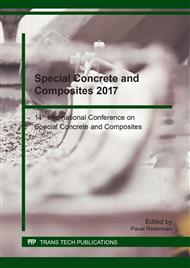[1]
O. Düğenci, T. Haktanir and F. Altun, Experimental research for the effect of high temperature on the mechanical properties of steel fiber-reinforced concrete. Constr. Build. Mater. 75 (2015) 82-8.
DOI: 10.1016/j.conbuildmat.2014.11.005
Google Scholar
[2]
J. Purkiss, Steel fibre reinforced concrete at elevated temperatures. Int. J. Cem. Compos. Lightweight Concr. 6 (1984) 179-84.
DOI: 10.1016/0262-5075(84)90006-x
Google Scholar
[3]
M. Cheyrezy, Structural applications of RPC. Concr. 33 (1999) 20-3.
Google Scholar
[4]
R. Sovják, T. Vavřiník, M. Frydrýn, T. Mičunek, J. Zatloukal and P. Máca, Residual velocity of the non-deformable projectile after perforating the ultra-high performance fibre reinforced concrete. SUSI 141 (2014) 257-64.
DOI: 10.2495/susi140221
Google Scholar
[5]
R. Sovják, T. Vavřiník, J. Zatloukal, P. Máca, T. Mičunek and M. Frydrýn, Resistance of slim UHPFRC targets to projectile impact using in-service bullets. Int. J. Impact, Eng. 76 (2015) 166-77.
DOI: 10.1016/j.ijimpeng.2014.10.002
Google Scholar
[6]
P. Richard and M.H. Cheyrezy, Reactive powder concretes with high ductility and 200-800 MPa compressive strength. Special Publ. 144 (1994) 507-18.
DOI: 10.14359/4536
Google Scholar
[7]
S. Grzeszczyk, Betony nowej generacji z proszków reaktywnych. Biul. Wojsk. Akad. Tech. 64 (2015) 103-11.
DOI: 10.5604/12345865.1168727
Google Scholar
[8]
C. Castillo, Effect of transient high temperature on high-strength concrete, Rice University, Houston, (1987).
Google Scholar
[9]
G.F. Peng, W.W. Yang, J. Zhao, Y.F. Liu, S.H. Bian and L.H. Zhao, Explosive spalling and residual mechanical properties of fiber-toughened high-performance concrete subjected to high temperatures. Cem. Concr. Res. 36 (2006) 723-7.
DOI: 10.1016/j.cemconres.2005.12.014
Google Scholar
[10]
C. Han, Concrete with spalling resistance. J. Korea Concr. Inst. 10 (1998) 5-10.
Google Scholar
[11]
M. Abid, X. Hou, W. Zheng and R.R. Hussain, High temperature and residual properties of reactive powder concrete – A review. Constr. Build. Mater. 147 (2017) 339-51.
DOI: 10.1016/j.conbuildmat.2017.04.083
Google Scholar
[12]
G. Peng, S. Chan and M. Anson, Chemical kinetics of CSH decomposition in hardened cement paste subjected to elevated temperatures up to 800° C. Adv. Cem. Res. 13 (2001) 47-52.
DOI: 10.1680/adcr.2001.13.2.47
Google Scholar
[13]
S. Roels, J. Carmeliet, H. Hens, O. Adan, H. Brocken, R. Černý, Z. Pavlík, Ch. Hall, K. Kumaran, L. Pel and R. Plagge, Interlaboratory comparison of hygric properties of porous building materials. JTEBS 27 (2004) 307-25.
DOI: 10.1177/1097196304042119
Google Scholar
[14]
ČSN EN 1015: Methods of test for mortar for masonry - Part 11: Determination of flexural and compressive strength of hardened mortar. Czech Standardization Institute. Prague (2000).
DOI: 10.3403/01905442u
Google Scholar
[15]
Z. Pavlík, M. Keppert, M. Pavlíková, J. Žumár, J. Fořt and R. Černý. Mechanical, hygric, and durability properties of cement mortar with MSWI bottom ash as partial silica sand replacement. CWB 19 (2014) 67-80.
DOI: 10.2495/arc120121
Google Scholar
[16]
E. Vejmelková, P. Konvalinka, P. Padevět, L. Kopecký, M. Keppert and R. Černý, Mechanical, Hygric, and Thermal Properties of Cement-Based Composite with Hybrid Fiber Reinforcement Subjected to High Temperatures. Int. J. Thermophys. 30 (2009).
DOI: 10.1007/s10765-009-0609-z
Google Scholar
[17]
E. Vejmelková, P. Konvalinka, P. Padevět, and R. Černý, Thermophysical and mechanical properties of fiber‐reinforced composite material subjected to high temperatures, J. Civ. Eng. Manag. 16 (2010) 395-400.
DOI: 10.3846/jcem.2010.45
Google Scholar
[18]
L. Scheinherrová, A. Trník, T. Kulovaná, P. Reiterman, I. Medveď, E. Vejmelková, and R. Černý, Thermal properties of high-performance concrete containing fine-ground ceramics as a partial cement replacement, J. Mater. Sci. 21 (2015) 444-8.
DOI: 10.5755/j01.ms.21.3.7160
Google Scholar
[19]
A. Rashad, Y. Bai, P. Basheer, N. Collier and N. Milestone, Chemical and mechanical stability of sodium sulfate activated slag after exposure to elevated temperature. Cem. Concr. Res. 42 (2012) 333-43.
DOI: 10.1016/j.cemconres.2011.10.007
Google Scholar
[20]
I. Štubňa, A. Trník and L. Vozár, Thermomechanical analysis of quartz porcelain in temperature cycles. Ceram. Inter. 33 (2007) 1287-91.
DOI: 10.1016/j.ceramint.2006.04.024
Google Scholar
[21]
W. Zheng, B. Luo and Y. Wang, Microstructure and mechanical properties of RPC containing PP fibres at elevated temperatures. Mag. Concr. Res. 66 (2014) 397-408.
DOI: 10.1680/macr.13.00232
Google Scholar
[22]
W. Zheng, B. Luo, Y. Wang, Compressive and tensile properties of reactive powder concrete with steel fibres at elevated temperatures. Constr. Build. Mater. 41 (2013) 844-51.
DOI: 10.1016/j.conbuildmat.2012.12.066
Google Scholar


